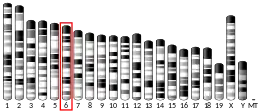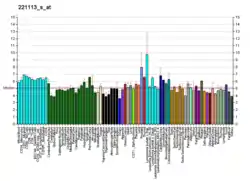Protein Wnt-16 is a protein that in humans is encoded by the WNT16 gene.[5][6] It has been proposed that stimulation of WNT16 expression in nearby normal cells is responsible for the development of chemotherapy-resistance in cancer cells.[7]
Function
The WNT gene family consists of structurally related genes that encode secreted signaling proteins. These proteins have been implicated in oncogenesis and in several developmental processes, including regulation of cell fate and patterning during embryogenesis. This gene is a member of the WNT gene family. It contains two transcript variants diverging at the 5' termini. These two variants are proposed to be the products of separate promoters and not to be splice variants from a single promoter. They are differentially expressed in normal tissues, one of which (variant 2) is expressed at significant levels only in the pancreas, whereas another one (variant 1) is expressed more ubiquitously with highest levels in adult kidney, placenta, brain, heart, and spleen.[6]
WNT16B expression is regulated by nuclear factor of κ light polypeptide gene enhancer in B cells 1 (NF-κB) after DNA damage, as can occur to normal cells during radiation or chemotherapy. Subsequently WNT16B signals in a paracrine manner to activate the Wnt expression program in tumor cells. The expression of WNT16B in the tumor microenvironment attenuates the effects of cytotoxic chemotherapy in vivo, promoting tumor cell survival and disease progression. This implies a mechanism by which cycles of genotoxic therapy might enhance subsequent treatment resistance in the tumor microenvironment.[7]
References
- 1 2 3 GRCh38: Ensembl release 89: ENSG00000002745 - Ensembl, May 2017
- 1 2 3 GRCm38: Ensembl release 89: ENSMUSG00000029671 - Ensembl, May 2017
- ↑ "Human PubMed Reference:". National Center for Biotechnology Information, U.S. National Library of Medicine.
- ↑ "Mouse PubMed Reference:". National Center for Biotechnology Information, U.S. National Library of Medicine.
- ↑ McWhirter JR, Neuteboom ST, Wancewicz EV, Monia BP, Downing JR, Murre C (Sep 1999). "Oncogenic homeodomain transcription factor E2A-Pbx1 activates a novel WNT gene in pre-B acute lymphoblastoid leukemia". Proceedings of the National Academy of Sciences of the United States of America. 96 (20): 11464–9. Bibcode:1999PNAS...9611464M. doi:10.1073/pnas.96.20.11464. PMC 18056. PMID 10500199.
- 1 2 "Entrez Gene: WNT16 wingless-type MMTV integration site family, member 16".
- 1 2 Sun Y, et al. (2012). "Treatment-induced damage to the tumor microenvironment promotes prostate cancer therapy resistance through WNT16B". Nature Medicine. 18 (9): 1359–68. doi:10.1038/nm.2890. PMC 3677971. PMID 22863786.
Further reading
- Smolich BD, McMahon JA, McMahon AP, Papkoff J (Dec 1993). "Wnt family proteins are secreted and associated with the cell surface". Molecular Biology of the Cell. 4 (12): 1267–75. doi:10.1091/mbc.4.12.1267. PMC 275763. PMID 8167409.
- Fear MW, Kelsell DP, Spurr NK, Barnes MR (Nov 2000). "Wnt-16a, a novel Wnt-16 isoform, which shows differential expression in adult human tissues". Biochemical and Biophysical Research Communications. 278 (3): 814–20. doi:10.1006/bbrc.2000.3852. PMID 11095990.
- Katoh Y, Katoh M (Apr 2005). "Comparative genomics on Wnt16 orthologs". Oncology Reports. 13 (4): 771–5. doi:10.3892/or.13.4.771. PMID 15756456.
- Mazieres J, You L, He B, Xu Z, Lee AY, Mikami I, McCormick F, Jablons DM (Aug 2005). "Inhibition of Wnt16 in human acute lymphoblastoid leukemia cells containing the t(1;19) translocation induces apoptosis". Oncogene. 24 (34): 5396–400. doi:10.1038/sj.onc.1208568. PMID 16007226. S2CID 2188646.
- Casagrande G, te Kronnie G, Basso G (Jun 2006). "The effects of siRNA-mediated inhibition of E2A-PBX1 on EB-1 and Wnt16b expression in the 697 pre-B leukemia cell line". Haematologica. 91 (6): 765–71. PMID 16769578.
- Sun Y, Campisi J, Higano C, Beer TM, Porter P, Coleman I, True L, Nelson PS (Sep 2012). "Treatment-induced damage to the tumor microenvironment promotes prostate cancer therapy resistance through WNT16B". Nature Medicine. 18 (9): 1359–68. doi:10.1038/nm.2890. PMC 3677971. PMID 22863786.




